Memory Performance: 16GB DDR3-1333 to DDR3-2400 on Ivy Bridge IGP with G.Skill
by Ian Cutress on October 18, 2012 12:00 PM EST- Posted in
- Memory
- G.Skill
- Ivy Bridge
- DDR3
Conversion – Xilisoft 7
Another classic example of memory bandwidth and speed is during video conversion. Data is passed between the memory and the CPU for processing – ideally faster memory here helps as well as memory that can deal with consecutive reads. Multiple threads on the CPU will also provide an additional stress, as each will ask for different data from the system. Our test uses two sets of conversions: first, a series of 160 videos have the first three minutes of each converted from various formats (480p to 1080p mkv) to AAC audio; and second is the motherboard testing, converting 32 1080p videos to iPod format. Each test is measured by the time taken to complete.
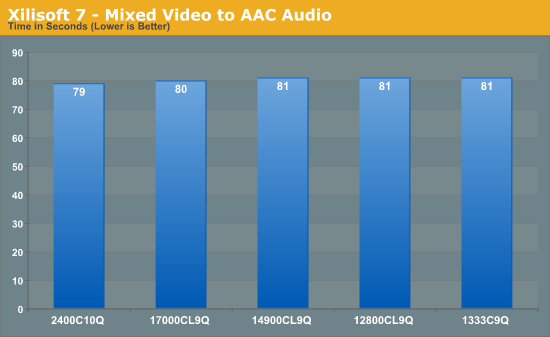
Converting to AAC seems to depend not on the memory – the movement of data from storage to memory to CPU is faster than the CPU can compute.
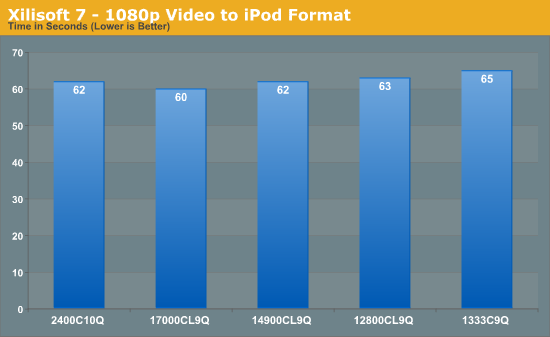
Video conversion is often one area quoted as being beneficial for memory speed, however these does not seem strictly true. As data is moved from storage to memory to the CPU, only if that memory transfer is the limiting factor does having faster memory help. In conversion to an iPod video format, that seems true moving from DDR3-1333 to DDR3-2133 just about, however it seems the limiting factor is still the CPU speed or the algorithm doing the conversion.
Folding on GPU
Memory usage is all algorithm dependent – if the calculation has a lot of small loops that do not require additional reads memory, then memory is unimportant. If the calculation requires data from other sources in those calculations, then memory can either be stressed randomly or sequentially. Using Ryan’s Folding benchmark as a platform, we are testing how much memory affects the serial calculation part of a standard F@H work unit.
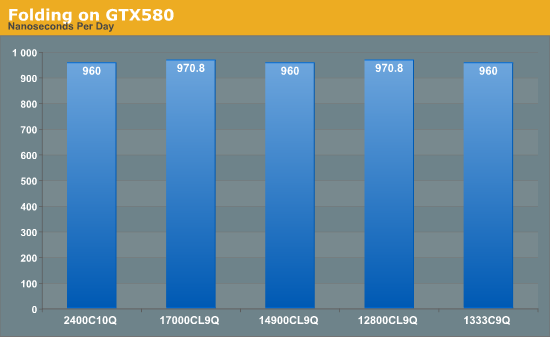
Unfortunately this test is only available to the nearest second, thus the benchmark finishes in either 89 or 90 seconds, giving appropriate ns/day. From the results, folding on GPUs is not affected by memory speed.
WinRAR x64 4.20
When compressing or converting files from one format to another, the file itself is often held in memory then passed through the CPU to be processed, then written back. If the file is larger than the available memory, then there is also loading time between the storage and the memory to consider. WinRAR is a variable multi-threaded benchmark, whereby the files it converts and compresses determines how much multi-threading takes place. When in multithreaded mode, the rate of cache misses can increase, leading to a less-than optimal scaling. Having fast memory can help with this.
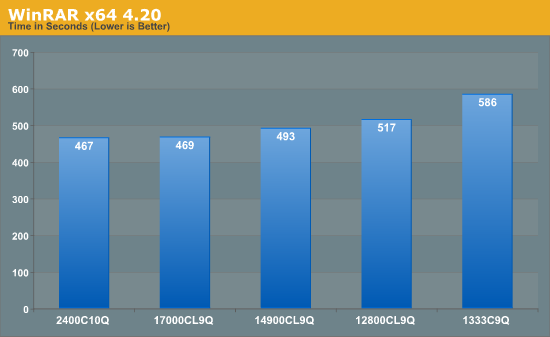
WinRAR is one of the benchmarks in our testing suite that benefits immensely from having faster memory. Moving from DDR3-1333 to DDR3-2400 speeds the process up by 20%, with the biggest gain moving from 1333 to 1600, and noticeable gains all the way up to 2133 C9.
Greysky's x264 HD 5.0.1
The x264 HD test, now version 5.0.1, tests the time to encode a 1080p video file into a high quality x264 video file. This test is standard across a range of reviews from AnandTech and other websites allowing for easy comparison. The benchmark is capable of running all cores to the maximum. Results here are reported as the average across four attempts for both the first and second passes.
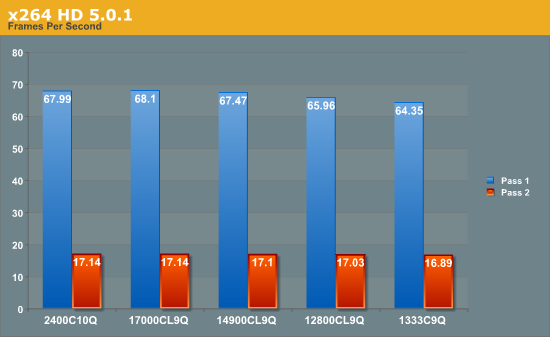
In another conversion test, we see that this benchmark gets a ~5% boost with faster memory, although Pass 1 sees a bigger boost than Pass 2. If conversion into x264 is the main purpose of the system, then the price premium of the faster memory could easily be justifiable.










114 Comments
View All Comments
just4U - Saturday, October 20, 2012 - link
Peaunut we are not talking 300-500 bucks here.. this is a 20-30 dollar premium which is nothing in comparison to what ram used to cost and how much more premium ram was as well.If your on a tight budget get 8Gigs of regular ram which is twice the amount of ram you likely need anyway.
Tech-Curious - Monday, November 5, 2012 - link
Thing is, these tests are for integrated graphics, unless I'm misreading something (AFAICT, the discrete card was only used for PhysX support; if I misread there then I apologize).Off the top of my head, there are basically three scenarios in which you're likely to want an IGP:
1) You're building an HTPC, in which case you prioritize (lack of) noise and (lack of) heat over graphics' power. If all you want to run are movies, then the IGP should be adequate regardless of the speed of your memory -- and if you want to play games, no amount of memory is going to turn an Intel IGP into an adequate performer on your average TV set these days. (Better to grab an AMD APU or just give up the ghost and grab a moderate-performance GPU.)
2) You're looking to run a laptop. But the memory reviewed in this article doesn't apply to laptops anyway.
3) You're on a tight budget.
So at best, we're talking about a fraction of a sliver of a tiny niche in the market, when we discuss the people who might be interested in wringing every last ounce of performance out of an IGP by installing high-priced desktop memory. Sure, the difference in absolute cost between the cheapest and the most expensive RAM here isn't going to make or break most people -- but people generally don't like to incur unnecessary costs either.
And people who are on a budget? They can save $80, just based on the numbers in the article, without making any significant performance sacrifice. That's real money, computer-component-wise.
tynopik - Thursday, October 18, 2012 - link
"I remember buying my first memory kit ever. It was a 4GB kit"makes you feel old
my first was 8MB
DanNeely - Thursday, October 18, 2012 - link
My first computer only had 16k.Mitch101 - Thursday, October 18, 2012 - link
VIC-203583 bytes free
jamyryals - Thursday, October 18, 2012 - link
wow :)just4U - Saturday, October 20, 2012 - link
The first computer i bough was a tandy 1000. I got them to put in 4 megs of ram.. at 50 bucks per meg.GotThumbs - Thursday, October 18, 2012 - link
Same here.I had purchased a used AT Intel 486DX 33Mhz powered system and upgraded it to 16mb around 1989. Overclocking it was done using jumpers on the motherboard. Heck, in HS I was a student assistant my senior year and recorded everyone's grades on a cassette tape drive using a Tandy (TS-80 I believe). It blows my mind thinking about how things have changed. There's more power/ram in a Raspberry PI than my first computer.
Best wishes for computing in the next ~30 years.
andrewaggb - Thursday, October 18, 2012 - link
Agreed, my first computer I owned personally was a 486 slc 33 (cyrix....) and I had a couple 1mb memory sticks, can't remember if those were called sims or something else. We had an apple 2+, trs 80, commodore 64, and ibm pc jr in the early-mid 80's but those were my dads :-), and some 286 that I can't remember the brand of.Just thinking about the e6400 as a first pc amuses me :-), that's still usable, and actually is when most of the computer fun started to die in my books. My current pc's are running phenom II 965, i5 2500k, i7 620m, i5 750, i7 720qm and I just have little motivation to upgrade anything ever.
Haswell is the first chip in a long time that I'm excited about. Everything else has been meh. And AMD... I had an amd 486-120,K6-200,K6-2 300,athlon xp 1800,2500, athlon 64 3200, athlon 64 x2 4800, 5600, phenom II 945,phenom x3, and my current 965 and a c-50 e netbook. man hard to believe all the computers I've had :-) Anyways, amd has nothing I want anymore, except cheap multicore cpus for running x264 all day.
IanCutress - Thursday, October 18, 2012 - link
E6400 wasn't the first PC... just the first processor I actually bought memory for. The rest were pre-built or hand-me-downs. :) I actually just took the same motherboard/chip out of my brother's computer (he has had it for a few years, with that memory) and bumped him up to Sandy Bridge. I'm still 27, and the E6400 system was new for me when I was around 21 or so. Since then I've got a Masters and a PhD - time flies when you're having fun!Ian